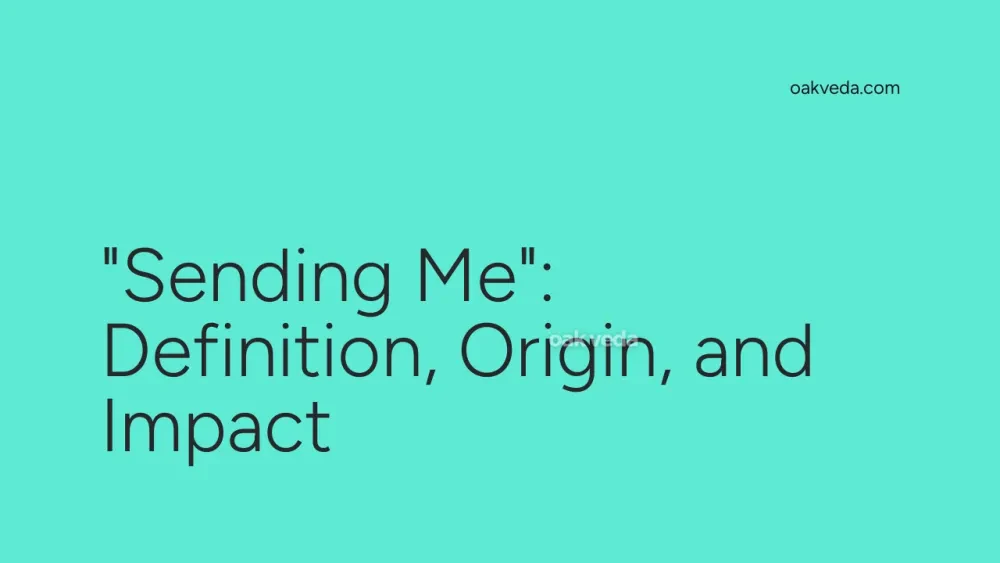
What is "Sending Me"?
"Sending me" is a popular slang phrase used across social media platforms to express a strong emotional reaction to something or someone. This versatile expression can convey a wide range of feelings, from extreme amusement and joy to frustration and annoyance. When someone says, "You're sending me" or "That's sending me," they're indicating that the subject has elicited an intense emotional response.
Origin and Development of "Sending Me"
The exact origin of "sending me" is difficult to pinpoint, as slang often evolves organically within communities. However, the phrase gained significant traction on social media platforms like Twitter and TikTok in the late 2010s. It's believed to have roots in African American Vernacular English (AAVE) and LGBTQ+ communities, where expressive language often flourishes before entering mainstream usage.
As with many internet slang terms, "sending me" quickly spread across various social media platforms, becoming a staple in online conversations and meme culture.
How "Sending Me" Works
The phrase "sending me" is typically used in the following ways:
- As a standalone expression: "This meme is sending me!"
- In response to something: "That cat video? Sending me."
- Directed at someone: "You're really sending me right now."
The beauty of this phrase lies in its versatility. It can be used to react to content, situations, or people, making it a go-to expression for many social media users looking to convey strong emotions succinctly.
Types or Variations of "Sending Me"
While "sending me" is the most common form, there are several variations and related expressions:
- "It sends": A shortened version with the same meaning.
- "I'm sent": Used to express that one has been thoroughly affected.
- "Sending me to the moon": An intensified version, implying an even stronger reaction.
- "This sends": Often used when sharing content that the poster finds particularly impactful.
Popular Examples of "Sending Me"
To better understand how "sending me" is used in context, consider these examples:
- On Twitter: "This video of a dog trying to catch a soap bubble is sending me 😂"
- In a TikTok comment: "The way he delivered that punchline? Sending me to another dimension!"
- On Instagram: "Your outfit is sending me! 🔥 Where did you get those shoes?"
Impact of "Sending Me" on Social Media Culture
The widespread adoption of "sending me" has had several notable impacts on social media culture:
-
Emotional Expression: It provides users with a quick, relatable way to express strong emotions, enhancing online communication.
-
Community Building: The phrase helps create a sense of shared language and culture among social media users.
-
Content Creation: Many content creators aim to produce material that will "send" their audience, driving engagement and virality.
-
Meme Evolution: "Sending me" has become a meme in itself, often incorporated into image macros and video content.
-
Language Evolution: Its popularity demonstrates how internet slang can quickly become part of everyday digital lexicon.
How Brands and Influencers Use "Sending Me"
Savvy brands and influencers have incorporated "sending me" into their social media strategies:
- Relatable Content: Brands use the phrase to appear more relatable and in touch with their audience.
- Engagement Boosting: Influencers might ask their followers what content "sends them" to increase interaction.
- Product Promotion: Some brands create campaigns around products or experiences that are meant to "send" customers.
- Trend Participation: Using the phrase allows brands and influencers to participate in trending conversations and increase visibility.
Future Trends Related to "Sending Me"
As with all internet slang, the future of "sending me" is uncertain. However, we can make some predictions:
- Evolution: The phrase may evolve or spawn new variations as users seek fresh ways to express themselves.
- Mainstream Adoption: It may continue to penetrate mainstream culture, potentially appearing in traditional media and advertising.
- Potential Decline: Like many trendy phrases, it could fall out of favor as newer slang emerges.
- Cross-Language Adoption: As global internet culture grows, we might see translations or adaptations in other languages.
FAQs about "Sending Me"
-
Is "sending me" always positive? No, while it's often used positively, it can also express frustration or annoyance.
-
Can "sending me" be used offline? Yes, like many internet phrases, it has started to be used in face-to-face conversations, especially among younger generations.
-
Is there an age limit for using "sending me"? While more common among younger users, there's no strict age limit. Anyone can use it, though it may seem less natural coming from older generations.
-
How do I know if something is "sending me"? If you have a strong emotional reaction – whether it's laughter, excitement, or even frustration – that's a good indicator that something is "sending you."
-
Can brands use "sending me" without seeming inauthentic? Yes, but it requires a good understanding of the phrase and its proper usage. Brands should use it naturally and in appropriate contexts to avoid seeming out of touch.
In conclusion, "sending me" has become a significant part of social media vernacular, offering users a concise way to express strong emotions. Its versatility and relatability have contributed to its widespread adoption, impacting how people communicate online. As digital culture continues to evolve, it will be interesting to see how this phrase adapts and what new expressions might emerge to capture the ever-changing landscape of online emotions.
You may be interested in:
- Hot Girl Walk: Definition, Origin, and Impact
- Shorby: Definition, Origin, and Impact on Social Media Marketing
- PSA (Public Service Announcement): Definition, Origin, and Impact
- "It's Giving": Definition, Origin, and Impact
- Mid: Definition, Origin, and Impact on Social Media
- Doxxing: Definition, Origin, and Impact on Social Media

